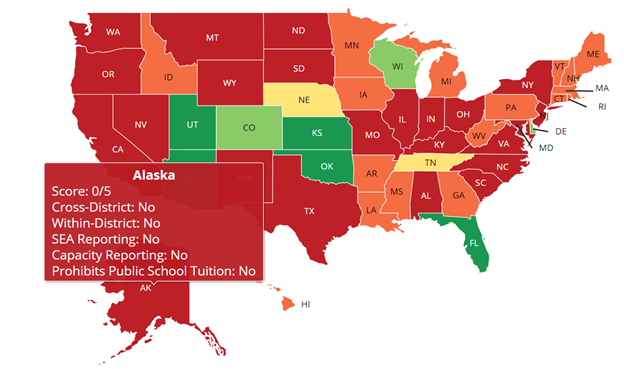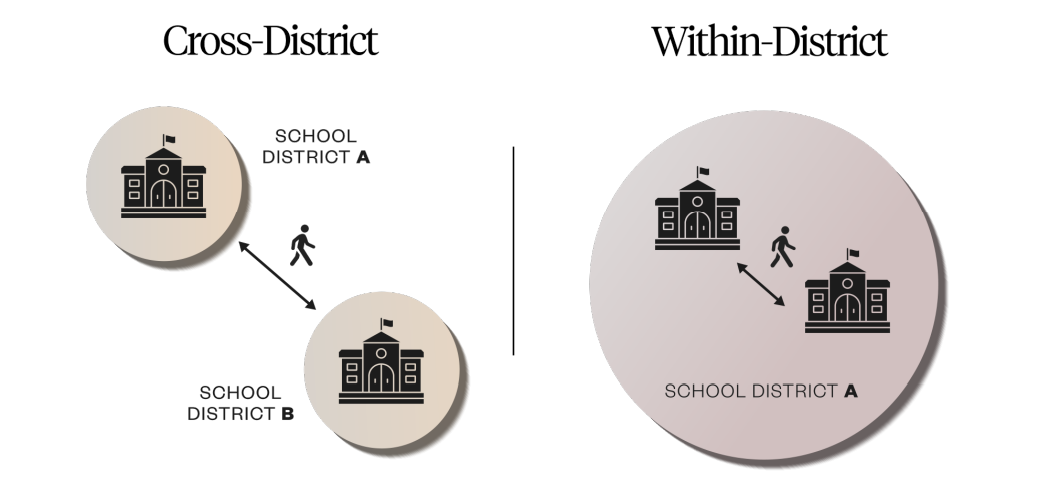The school children attend is too often dictated by the location of their families’ residences, which makes it difficult to access education options that are a better fit for many families. K-12 open enrollment allows children to enroll in any public school so long as there are seats available. Open enrollment helps foster competition for excellence among schools and districts, as well as addresses property wealth and fairness concerns.
Yet only 11 states have mandatory open enrollment laws, and Alaska isn’t one of them. The Reason Foundation ranked all 50 states based on five best practices for open enrollment and found Alaska fell short in every category. Figure 1 shows the map of U.S. rankings for open enrollment with Alaska’s performance in each category highlighted.

To make education options easier for families to access regardless of zip code, Alaska should consider implementing five policies. The first is mandatory cross-district open enrollment; school district policy should be transparent and districts should only be allowed to reject transfer students for limited reasons, such as capacity within the school. It should also be easier for students to transfer schools within a school district with mandatory within-district open enrollment, and transfer requests should only be rejected for similarly limited reasons. Figure 2 below shows the difference between these two types of open enrollment. For cross-district and within-district open enrollment, application deadlines and procedures should be posted clearly on districts’ websites.

Reason also lists several transparency requirements as best practices. The state education agency (SEA) should be annually collecting and publicly reporting open enrollment data by school district, including “transfer students accepted, transfer applications rejected, and the reasons for rejections.” Districts should also be required to publicly report “seating capacity by school and grade level,” so that families have data about available school seats. Finally, all children should have free access to all public schools, and therefore school districts should not be permitted to charge transfer tuition to families.
Alaska does not demonstrate any of these best practices. The report notes that “Alaska does not have mandatory or voluntary cross-district or within-district open enrollment policies.” While cross-district open enrollment might be considered less useful in Alaska where districts can span hundreds of thousands of miles, students in Alaska’s urban areas should be allowed to switch to schools in nearby districts if they would be better served by the education in that school. Within-district open enrollment would be beneficial for many Alaskan families; as long as there is more than one public school serving children in their grade level and there is adequate capacity in another school, a family should be allowed to enroll their student. While there are statewide options like the correspondence school allotment program, many parents might still prefer traditional public schools — simply better ones than their child is zoned to attend.
Alaska’s state education agency does not require districts to publicly report school capacity, the number of transfers, and reasons why transfer applications were rejected. What is most astounding, however, is that “Alaska’s current policy permits school districts to charge tuition to the families of transfer students when the student’s grade level is offered in their assigned district and the assigned district does not accept the billing.” Public schools should be free to all students regardless of district boundaries.
Several states do well in promoting open enrollment policies. Approximately 9% of Wisconsin’s students utilized the cross-district transfer option in the 2020-2021 school year, with the program growing more than 2,700% since 1998. Wisconsin does not permit districts to charge tuition to transfer students and has some of the best transparency practices regarding open enrollment. In fact, the state’s per-pupil funding “follows transfer students to their new school districts,” which incentivizes all districts to enroll transfer students.
All school districts in Florida must participate in both cross- and within-district open enrollment and all schools must regularly report the number of available seats by grade level. Nearly 273,500 students used Florida’s open enrollment options, and more than half are eligible for free and reduced-price lunches, showing that low-income families use open enrollment to access education options outside of their assigned traditional public school.
Reason recommends that Alaskan school districts implement mandatory cross-district enrollment with transparent application requirements and only be allowed to reject applications on limited bases such as insufficient capacity. It is also recommended that districts publicly report seating capacity by school and grade level at least annually.
